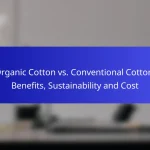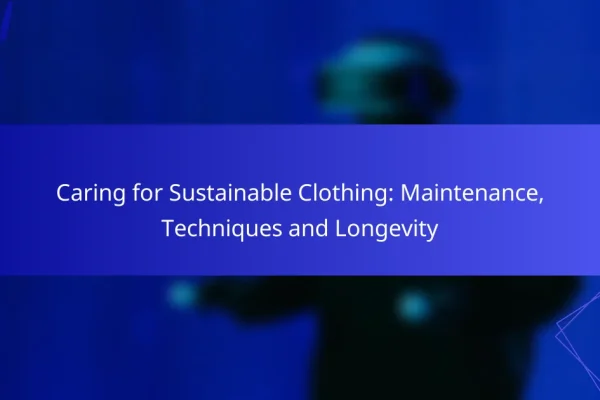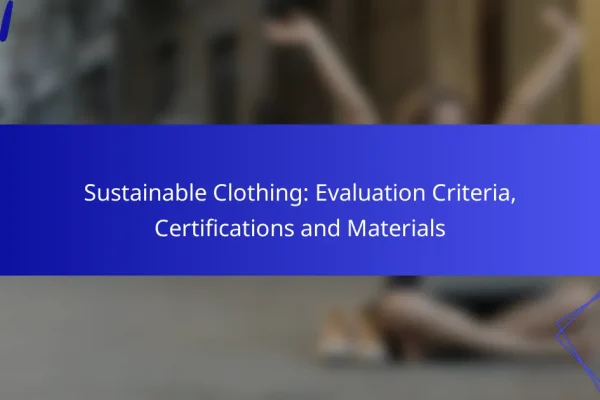How can I shop sustainably in major cities?
Shopping sustainably in major cities involves making conscious choices that support eco-friendly practices and local economies. Focus on sourcing from local brands, utilizing second-hand options, and engaging in community-driven initiatives to reduce your fashion footprint.
Choose local sustainable brands
Local sustainable brands often prioritize ethical production methods and environmentally friendly materials. By supporting these businesses, you contribute to the local economy and reduce the carbon footprint associated with shipping products over long distances.
Look for brands that are transparent about their supply chains and use sustainable practices, such as organic cotton or recycled materials. Many cities have directories or online platforms that highlight these brands, making it easier to shop consciously.
Utilize thrift stores and consignment shops
Thrift stores and consignment shops offer a treasure trove of second-hand clothing at affordable prices. Shopping at these locations not only saves money but also extends the life cycle of garments, reducing waste in landfills.
When visiting thrift stores, consider checking back regularly as inventory changes frequently. Look for high-quality items that may need minor repairs, as this can be a sustainable way to refresh your wardrobe without buying new.
Participate in clothing swaps
Clothing swaps are community events where individuals exchange garments they no longer wear. This practice promotes sustainability by keeping clothing in circulation and reducing the demand for new items.
To participate, gather friends or join local groups that organize swaps. Bring clean, gently used clothing and be open to trying new styles. This not only refreshes your wardrobe but also fosters a sense of community and shared responsibility for sustainable fashion.
What are the best sustainable fashion brands?
The best sustainable fashion brands prioritize eco-friendly materials, ethical labor practices, and transparency in their supply chains. These brands not only offer stylish clothing but also contribute positively to the environment and society.
Patagonia
Patagonia is renowned for its commitment to environmental responsibility and ethical manufacturing. The brand uses recycled materials in many of its products and actively supports various environmental initiatives.
When shopping at Patagonia, consider their Worn Wear program, which encourages customers to buy used items or trade in their old gear. This initiative helps reduce waste and promotes a circular economy.
Everlane
Everlane focuses on “radical transparency,” providing detailed information about their factories and the true cost of their products. They offer a range of basics that are both stylish and sustainably made.
Look for Everlane’s “Choose What You Pay” model, which allows customers to select from different price points based on their budget. This approach helps make sustainable fashion accessible while ensuring fair wages for workers.
Reformation
Reformation is a leader in sustainable fashion, known for its trendy designs and eco-friendly practices. The brand uses sustainable fabrics and has a strong commitment to reducing its carbon footprint.
When shopping with Reformation, check their sustainability scorecards on each product page, which detail the environmental impact of each item. This transparency helps consumers make informed choices that align with their values.
How to identify sustainable materials?
To identify sustainable materials, look for fabrics that are produced with minimal environmental impact and ethical labor practices. Key indicators include certifications, the source of the fibers, and the manufacturing processes used.
Look for organic cotton
Organic cotton is grown without synthetic pesticides or fertilizers, making it a more eco-friendly option compared to conventional cotton. When shopping, check for certifications like the Global Organic Textile Standard (GOTS) to ensure the cotton is genuinely organic.
Additionally, organic cotton often uses less water than conventional methods, which is beneficial in regions facing water scarcity. Look for clothing labeled as made from 100% organic cotton for the best impact.
Check for Tencel or Lyocell
Tencel, or Lyocell, is made from sustainably sourced wood pulp, primarily from eucalyptus trees. The production process is closed-loop, meaning that solvents used are recycled, reducing waste and environmental harm.
When shopping, seek out garments labeled with Tencel or Lyocell, as these fabrics are biodegradable and often softer than traditional fibers. They also have moisture-wicking properties, making them comfortable for wear.
Avoid synthetic fibers
Synthetic fibers like polyester and nylon are derived from petroleum and can take hundreds of years to decompose. Their production is energy-intensive and often involves harmful chemicals, contributing to pollution.
When choosing clothing, avoid items labeled with these materials, especially if they are not recycled. Instead, opt for natural or recycled alternatives that are more sustainable and have a lower environmental footprint.
What are the benefits of sustainable fashion?
Sustainable fashion offers numerous advantages, including reduced environmental harm and improved social equity. By prioritizing eco-friendly materials and ethical labor practices, consumers can contribute to a healthier planet and fairer working conditions.
Reduces environmental impact
Sustainable fashion significantly lowers the environmental footprint of clothing production. This includes minimizing water usage, reducing carbon emissions, and decreasing waste generated by fast fashion. For instance, choosing organic cotton over conventional cotton can cut water consumption by up to 90%.
Additionally, sustainable brands often utilize recycled materials, which helps divert waste from landfills. When shopping, look for certifications like Global Organic Textile Standard (GOTS) or OEKO-TEX, which indicate environmentally friendly practices.
Supports ethical labor practices
Ethical labor practices are a cornerstone of sustainable fashion, ensuring fair wages and safe working conditions for garment workers. Many sustainable brands are transparent about their supply chains, allowing consumers to make informed choices. Supporting these brands can help improve the livelihoods of workers in developing countries.
When shopping, seek out companies that adhere to fair trade principles or have certifications like Fair Trade Certified. This not only supports ethical practices but also encourages more brands to adopt similar standards.
Promotes circular economy
The circular economy model in fashion emphasizes reusing, recycling, and repurposing materials to extend the lifecycle of garments. This approach reduces waste and encourages sustainable consumption habits. Brands that promote take-back programs or offer repair services help facilitate this model.
Consider participating in clothing swaps or purchasing second-hand items to contribute to a circular economy. These practices not only reduce demand for new clothing but also help keep textiles out of landfills, fostering a more sustainable fashion ecosystem.
How to evaluate a brand’s sustainability?
To evaluate a brand’s sustainability, look for specific indicators that demonstrate their commitment to environmentally friendly practices. Key factors include certifications, transparency in operations, and ethical sourcing of materials.
Check for certifications like GOTS
Certifications such as the Global Organic Textile Standard (GOTS) indicate that a brand adheres to strict environmental and social criteria throughout its supply chain. Look for labels that confirm organic materials, responsible dyeing processes, and fair labor practices.
Other notable certifications include Fair Trade, OEKO-TEX, and the Responsible Wool Standard. Each certification has its own focus, so understanding what they entail can help you make informed choices.
Review brand transparency reports
Brand transparency reports provide insights into a company’s practices, including sourcing, labor conditions, and environmental impact. A sustainable brand should openly share information about its supply chain and efforts to reduce its carbon footprint.
When reviewing these reports, check for specific details like the percentage of sustainable materials used, waste reduction initiatives, and labor policies. Brands that are committed to sustainability often publish annual reports or updates on their websites.
What are the trends in sustainable fashion shopping?
Sustainable fashion shopping is increasingly characterized by a focus on eco-friendly materials, ethical production practices, and a shift towards second-hand and vintage clothing. Consumers are becoming more aware of the environmental impact of their purchases, leading to a greater demand for transparency and sustainability in the fashion industry.
Growing Demand for Transparency
Shoppers are now prioritizing brands that provide clear information about their supply chains and production methods. This trend encourages companies to disclose their sourcing practices, labor conditions, and environmental impact. Brands that fail to be transparent may lose customers who are committed to ethical consumption.
Rise of Second-Hand Shopping
Second-hand shopping is gaining popularity as consumers seek to reduce waste and find unique pieces. Thrift stores, online resale platforms, and clothing swaps are becoming mainstream options. This shift not only supports sustainability but also allows shoppers to save money while exploring diverse styles.
Emphasis on Eco-Friendly Materials
More brands are incorporating sustainable materials such as organic cotton, Tencel, and recycled fabrics into their collections. These materials often have a lower environmental impact compared to conventional textiles. Consumers are encouraged to look for certifications like GOTS (Global Organic Textile Standard) or OEKO-TEX to ensure the sustainability of their purchases.
Support for Local and Ethical Brands
Many shoppers are turning to local and ethical brands that prioritize fair labor practices and environmentally friendly production. Supporting these businesses not only helps reduce carbon footprints associated with shipping but also fosters community growth. Researching local options can lead to discovering high-quality, sustainable fashion alternatives.










